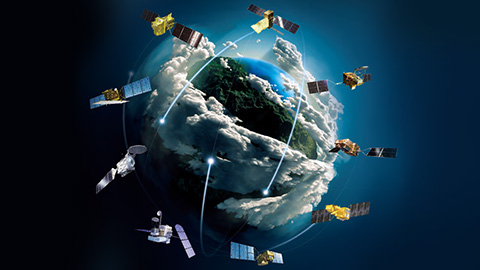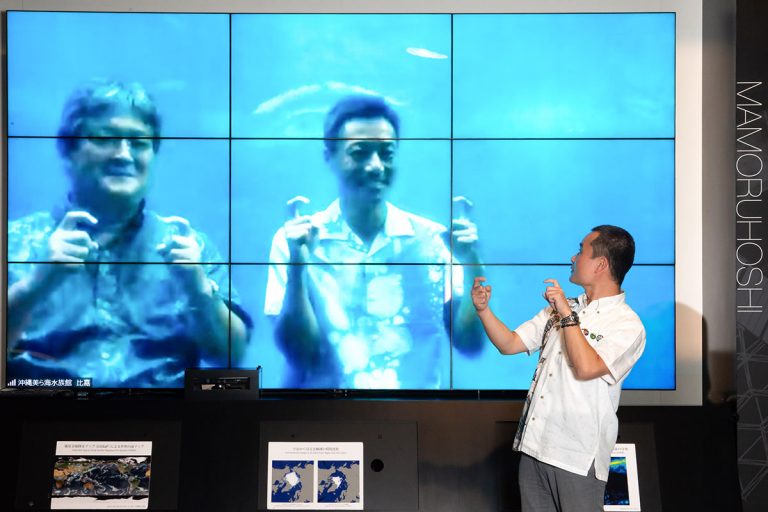

2022.02.25 Fri
Protecting nature from ocean and space like a tag-team will create a new world.
Special talk
Okinawa Churaumi Aquarium
[Website renewal event] Special talk
Okinawa Churaumi Aquarium × JAXA Space Technology Directorate I
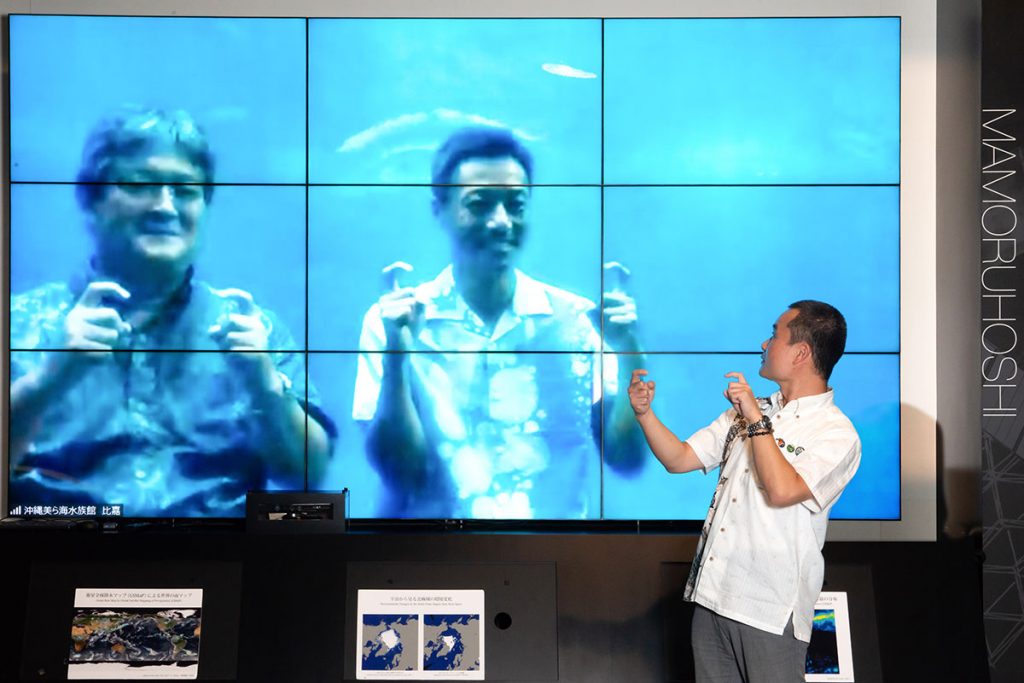
Space and ocean are vast and mysterious fields. The specialists looking at the Earth’s nature environment as their work in the fields are all here!
The specialists from “Okinawa Churaumi Aquarium” which is the most visited aquarium in Japan are Dr. Sato Keiichi, the General Manager of the aquarium as well as a researcher, and Dr. Matsumoto Rui, the Manager of Fish husbandry section, as well as a researcher of shark. The specialist from Space Technology Directorate 1 of JAXA, is Mr. Mizukami Yosei, who is in charge of analysis and research of satellite images.
Three people who love the ocean in Okinawa talked about their work and the future of the Earth.
This special event was conducted remotely between Okinawa Churaumi Aquarium and JAXA Tsukuba Space Center due to COVID-19.
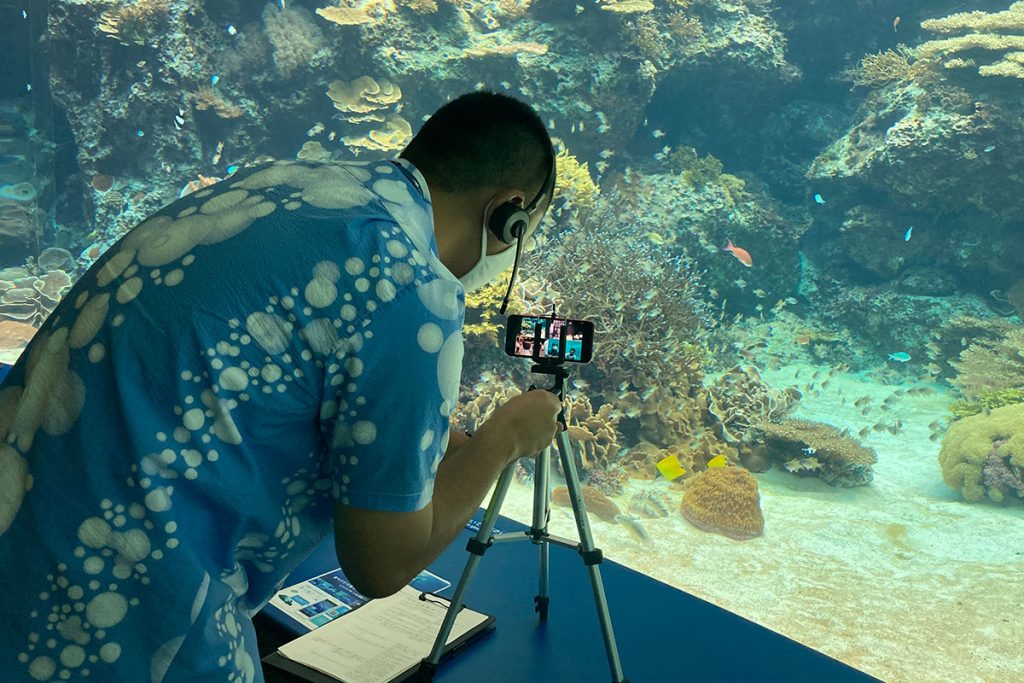
(Event date: September 24th, 2021)
Dr. Sato Keiichi
General Manager of Aquarium, Okinawa Churashima Foundation
He is responsible for the overall management and operation of the aquarium including animal care/survey and research and the facility management. He is also a senior researcher of the Okinawa Churashima Foundation Research Center, and engaged in research related to the anatomy and the reproductive ecology of sharks.
Dr. Matsumoto Rui
Manager of Fish husbandry section, Okinawa Churashima Foundation
He is in charge of collecting, breeding and managing creatures which we can meet at the aquarium, and producing the fascinating display. He also researches large migratory fishes like whale sharks and manta rays as Dr. Shark at the Research Center.
Mr. Mizukami Yosei
Associate Senior Researcher, Earth Observation Research Center (EORC), Space Technology Directorate I, Japan Aerospace Exploration Agency (JAXA)
He is in charge of analysis, research of satellite images and its application promotion. He is engaged in research related coral and seaweed mapping using satellite images of “DAICHI” (ALOS) observing environment on the Earth. He is also involved in research to promote the utilization of “DAICHI-3” (ALOS-3) to be launched in FY2021.
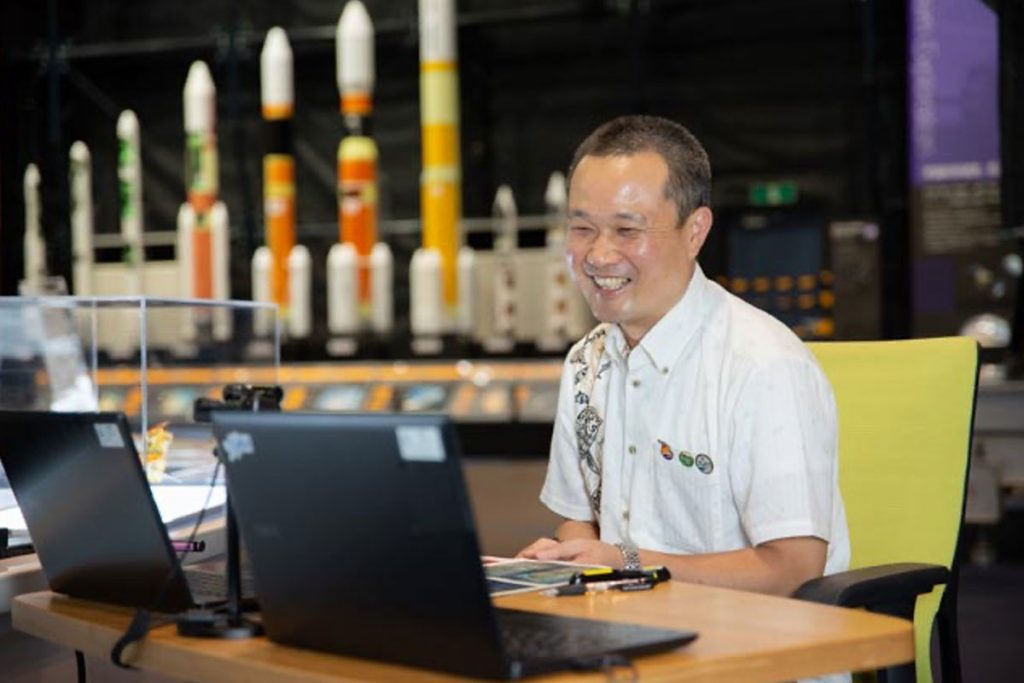
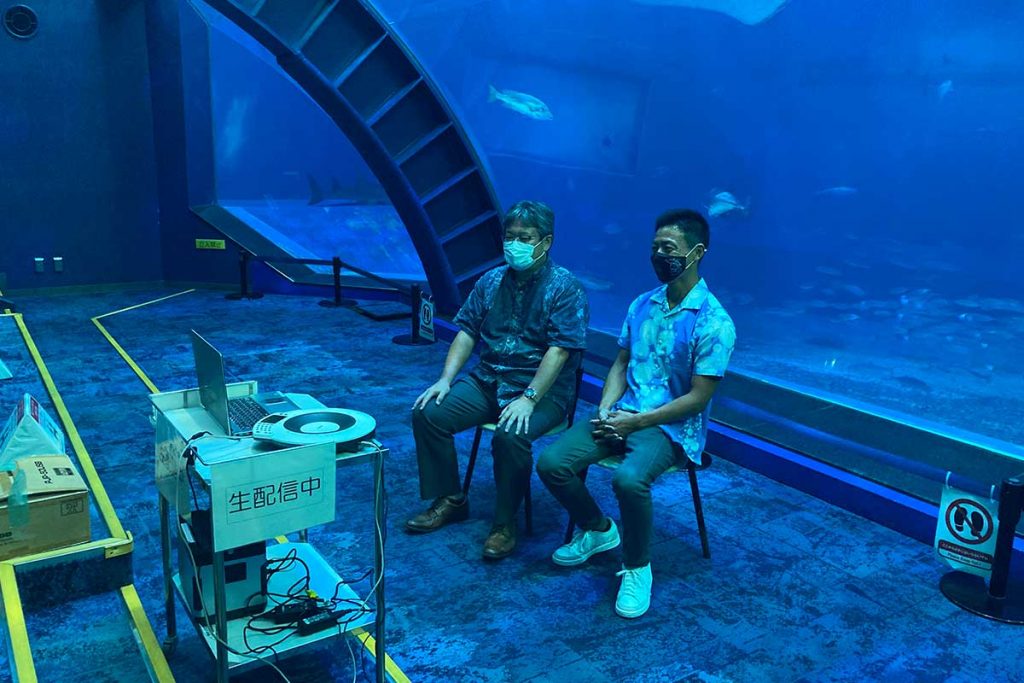
Coral reef in Okinawa, one of the world’s rarest and most beautiful
I work for Earth Observation Research Center (EORC) of JAXA and I’m responsible for analyzing satellite image data of various global environment. The subject I am particularly focusing on is coral reef monitoring in coastal areas of Japan and the world. For example, I’m addressing issues such as what kind of environment coral reef used to be using satellite images of “DAICHI” (ALOS), and how “DAICHI-3” (ALOS-3) to be launched in the near future can be used to learn about the current state of coral reef in detail. The target of this research and study is the ocean and coral reef in Okinawa, so I’m always feeling that the coral reef in Okinawa is great.
I’ve heard that a variety of corals are distributed around Okinawa, which is rare in the world. The ocean around Motobu-cho Ishikawa on Motobu Peninsula, where the Okinawa Churaumi Aquarium is located, is almost untouched by human hands, so there is still unspoiled coral reef. As part of my job, I often go out to the sea on a boat. Every time I see coral reef, I think how beautiful it is.
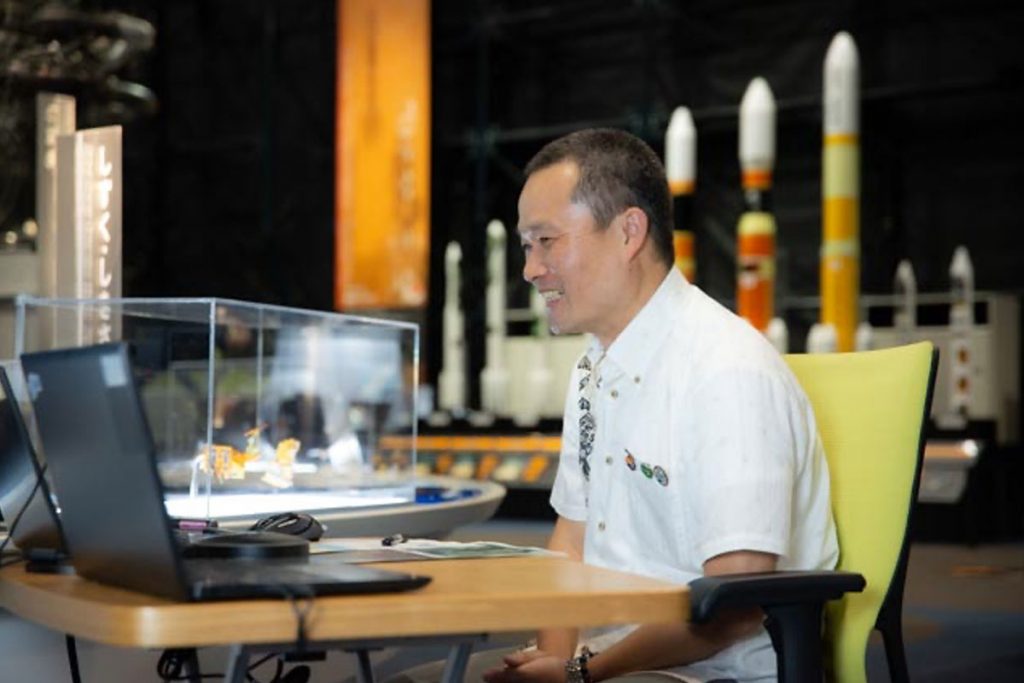
Now the target area I’m working on research on coral reef is Onna-son sea in Okinawa. When I am also planning to select the ocean area around Motobu-cho Ishikawa close to Okinawa Churaumi Aquarium as the next target, I have a chance to talk with you, so I felt a strong connection.
I’m glad to hear that. Do you often come to Okinawa?
I had often visited there for the field survey of coral reef before the COVID-19 crisis. Furthermore, for the missions at the former department, I had visited Onna-son many times for maintenance of the satellite tracking antenna and the new instrument development and its demonstration at JAXA Okinawa Tracking and Communications Station.
Why were you into a coral reef?
That was in my graduate school days. When I started to research coral reef, I saw it with my own eyes in the ocean of Ishigaki island for the first time. In the coral reef, there were multicolored corals like a flower field, colorful and small fish and seaweed bed with thick growth of seaweed. Many kinds of creatures live in such small space called “Coral reef”, and it looked like a forest in the ocean. I felt that the coral reef protects a variety of lives like a cradle. So I was hooked on it completely.
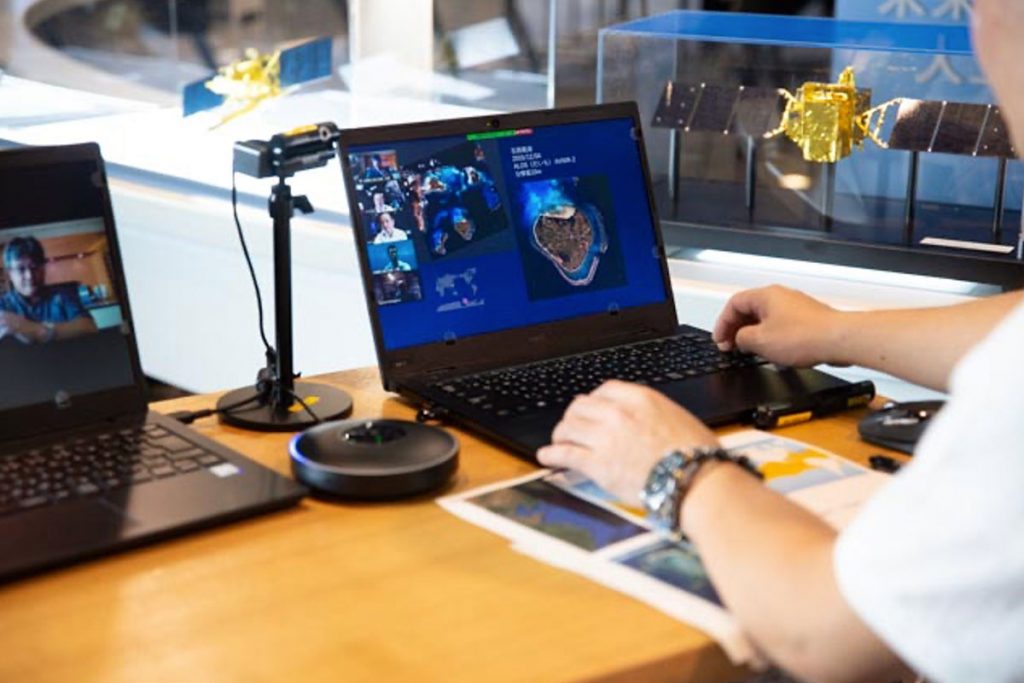
The coral reef in Okinawa is quite unique. It seems that there is no other place in the world where such large-scale coral reef spreads out around the islands with such high latitude and high population density.
Maybe this is the place where it’s being tested how human can live while protecting nature, I think.
Mizukami-san, please tell us about your research of coral reef.
I’m trying to analyze how corals and seaweed bed are distributed using satellite images. It’s becoming clear that the seaweed bed plays a role in absorbing carbon dioxide, known as “Blue carbon.” The survey of seaweed bed including its distribution and growing situation is an important element of addressing global warming.
How does the coral reef look like from satellites?
There are magnified views of Motobu-cho Ishikawa area observed by DAICHI (ALOS) in 2007, though it’s old.
I believe it’s hard to tell which is coral and which is seaweed bed, if we are looking for them from this image. That is why I am researching the possibility of using computer processing which is utilized the characteristics of each light reflections in order to classify coral and seaweed. But it’s quite hard for me, and challenging issue.
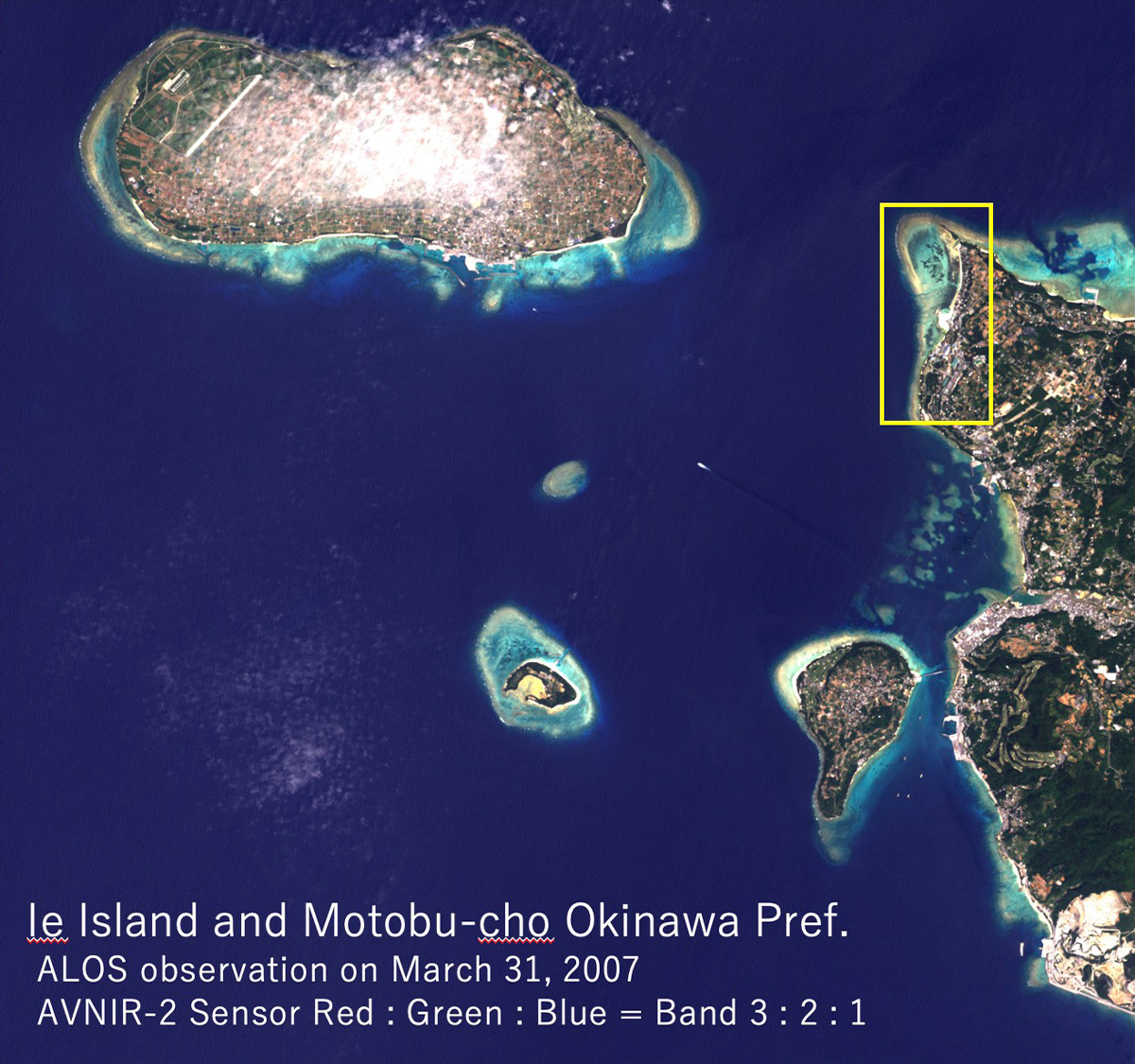
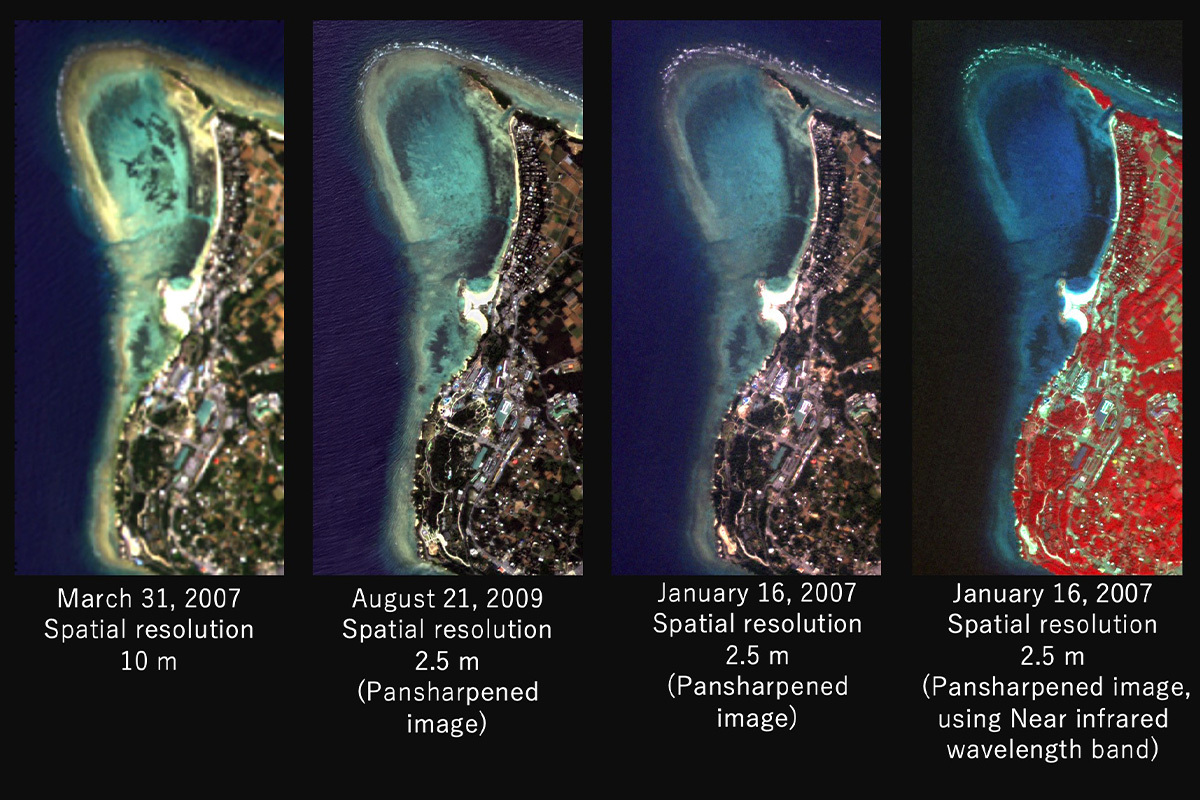
When observing under the sea using satellites, is there any interference from being covered seawater?
Satellites capture the intensity of light that is reflected from sea floor after the sunlight hit it. Differences in water depth and tide level affect the intensity of light. Earth observation satellites pass above the same place at roughly the same time to take pictures, but the tide level is always changing. Finding a method to compensate for these differences is one challenge.
After raining, seawater clarity decreases due to the effects of sediment runoff into the sea. Such suspended solid can also be an error factor.
Furthermore, unfortunately satellites cannot capture conditions of the Earth when it is cloudy. I select the satellite images that meet the requirements for the analysis from many images taken by satellite repeatedly.
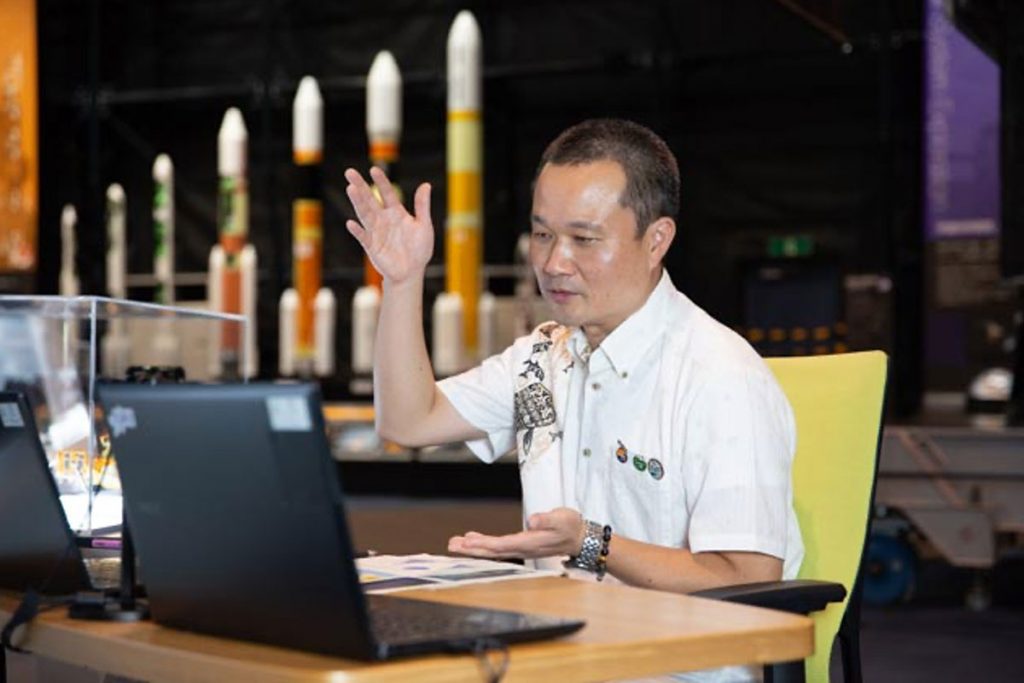
I’m very interested in the coral distributions captured from high altitude like satellites, because we are able to confirm them at a large area relatively at once.
Recently, we started to use a drone for our survey of coral reef and seaweed bed.
“DAICHI-3” (ALOS-3) will be launched soon, which is capable to capture objects that are 80 centimeters in size in black and white with a panchromatic sensor and 3.2 meters in size in color with a multi-spectral sensor. This means that we will be able to get satellite images clearer than the old images I showed you before. The new satellite data allow us to distinguish between coral and seaweed bed from the difference in shape. I hope to make clearer, more detailed images and coral/seaweed bed map.
I’m looking forward to that.
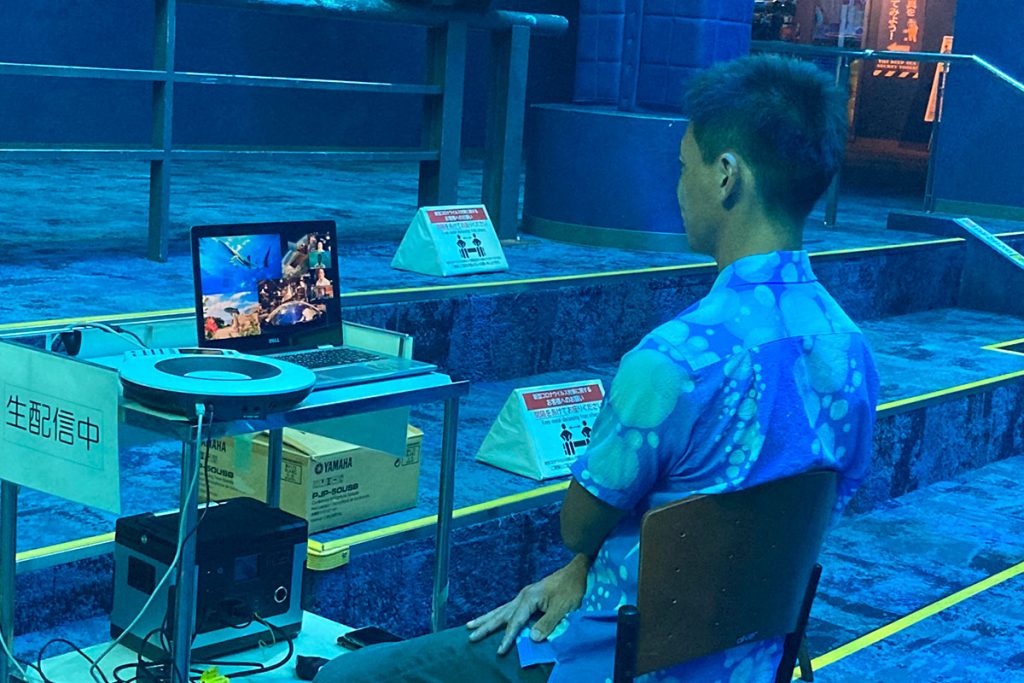
Reference
ALOS Research and Application Project ALOS-3 Overview
Rising sea temperatures due to climate change afflicts coral reef.
Corals in Okinawa are beautiful, but recently, it seems we’ve seen some coral bleaching which a coral turns white.
There seems to be two primary causes of the coral bleaching.
One of them is the development of coastal areas. The coastal areas are being reclaimed and constructed in order to secure land and roads, because Okinawa, especially in the south-central parts of the island, is as densely populated as the Tokyo metropolitan area.
The other is higher sea temperatures due to global warming, which is the global issue.
Are you making any efforts at Churaumi Aquarium?
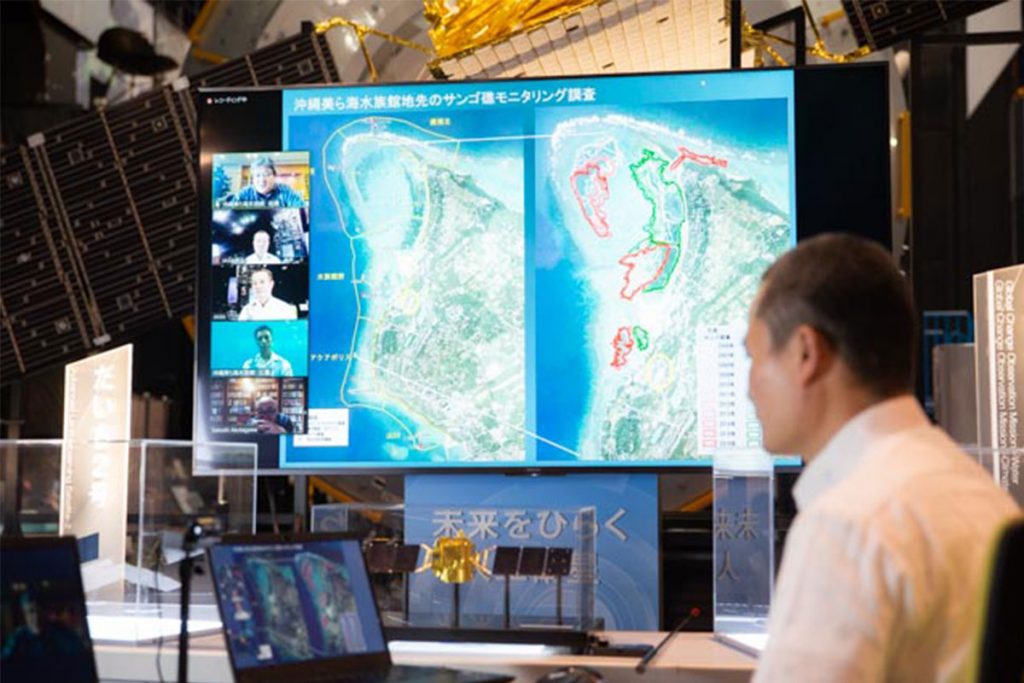
We have been monitoring coral reef around Motobu-cho Ishikawa where our aquarium is located for over 20 years, in order to observe how the environment of coral reef changes on long-term basis.
According to the observation, coral communities become smaller and larger. We are especially focusing on coral communities distributed in the reef flat, where the sea is shallow, and the water temperature rises very easily when there are no typhoons in the summer. If the temperature rises over 30 degrees, the coral bleaching occurs remarkably. In the case that the period of high temperature is short, the corals will recover from its bleaching. But in the case that it becomes longer, the corals will bleach and die.
What we can do is to build up basic knowledge and to take advantage of them for the future prediction through our monitoring.
Coral Reef Monitoring Survey near Okinawa Churaumi Aquarium
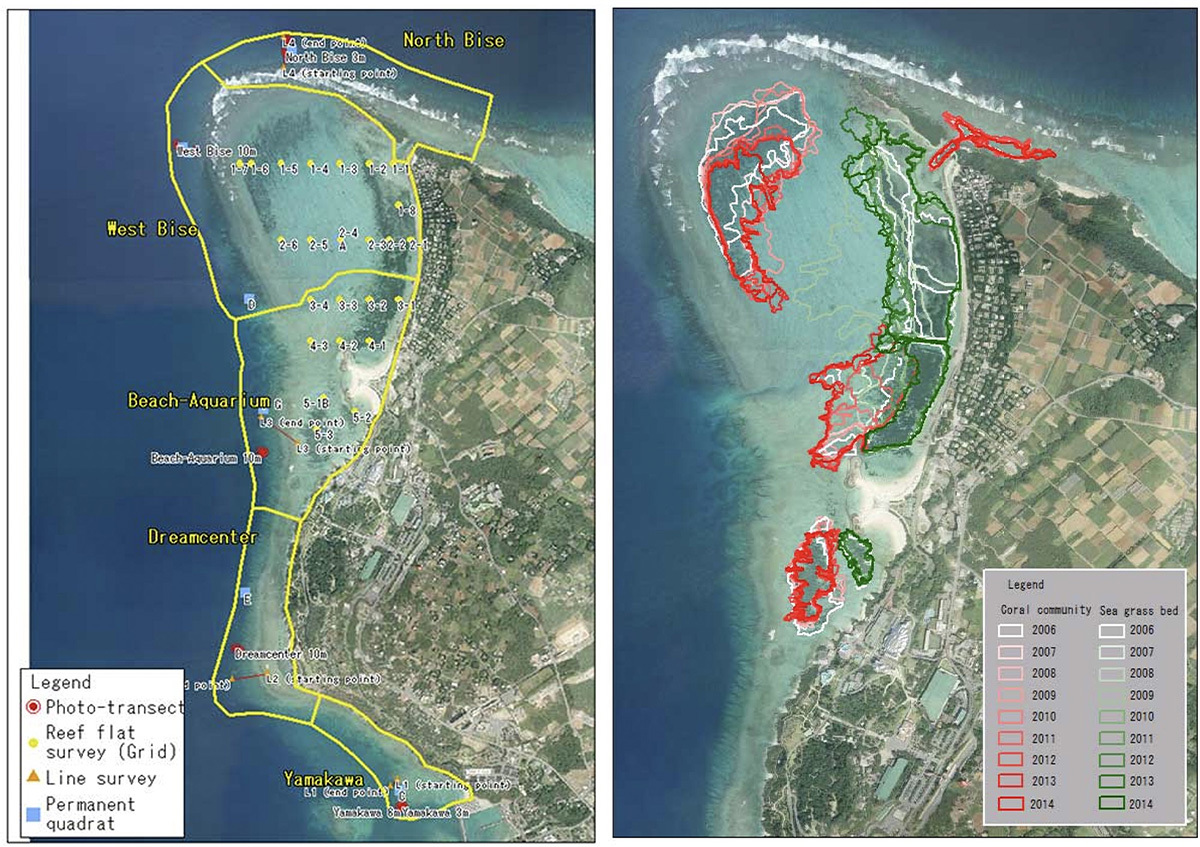
We’re doing the same thing. It is important to make observations repeatedly and to accumulate data continuously. Satellite observation areas are not only Japan but around the world. Even if the coral bleaching does not occur in Japan, it is possible that it occurs somewhere else in the world. By detecting such coral bleaching from image analysis, it may become our important mission to issue alerts “Bleaching is occurring in this area.”
Is it possible to measure the sea temperature using satellites?
Yes, our satellites, “SHIKISAI” (GCOM-C) and “SHIZUKU” (GCOM-W) are capable of measuring the sea surface temperature.
For example, you mentioned earlier that the sea surface temperature drops after a typhoon passed. These images are based on data of NASA’s satellite Aqua(※1). You can see the sea surface temperature dropping by passing the typhoon from July 17 to 20, 2011.
※1
NASA’s Earth observation satellite Aqua is carrying AMSR-E (The Advanced Microwave Scanning Radiometer for EOS) developed by JAXA, which is capable of measuring water vapor, precipitation, sea surface temperature, sea surface winds, ice, snow and so on.
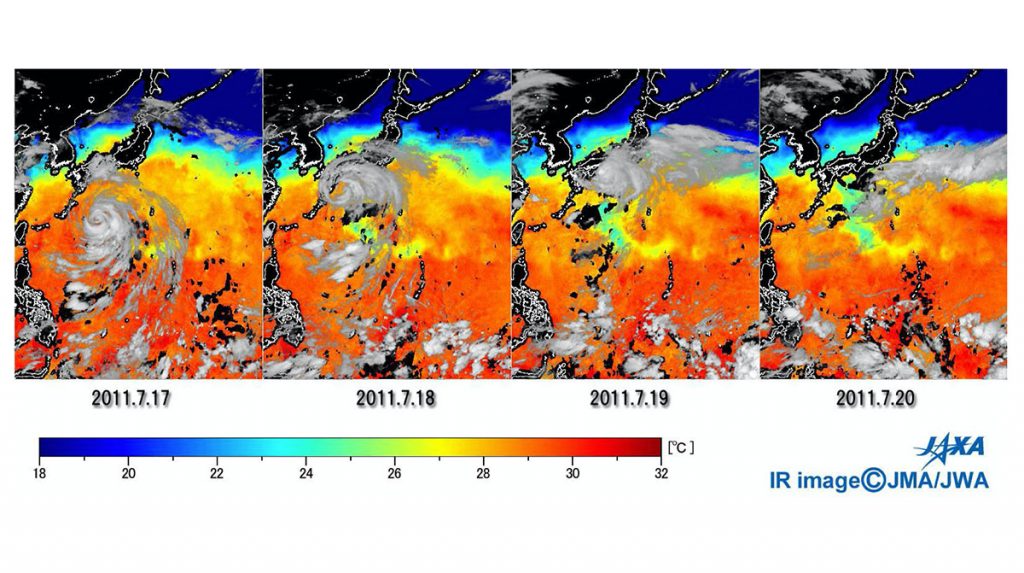
Reference
Drop in sea surface temperature after the passage of typhoon
Measuring the decline of sea surface temperature from satellite during typhoon passage
Satellite observations related torrential rain in July 2020 (Japanese only)
It’s clear at a glance. I think typhoons and coral reef in Okinawa are inseparable. If typhoons do not pass regularly every year, rising sea temperatures could have a significant impact on creatures in coral reef. Sea temperature of 30 degrees could be dangerous for sea creatures.
At Okinawa Churaumi Aquarium, the seawater in the tanks is supplied directly from the ocean in front of us, and we don’t control the temperature. So the temperature in the tank rarely rises over 30 degrees.
Does this mean that the coral bleaching can occur in your tanks?
That’s right. If so, based on the past experiences and data, we try to lower the temperature about 0.5 degrees, by blocking the sunlight to the tanks in advance and connecting the pipes to the cooling water as our last resort.
Approach to the biology of whale sharks, the most popular creatures in the aquarium
Does the sea temperature affect to other creatures in the aquarium?
If the temperature in the tank rises over 30 degrees, whale sharks suffer from summer heat fatigue and do not eat. They lose weight if the summer fatigue lasts a long time. When they are in health, they are waiting for food on the surface near the feeding time before I call them, though.
I see. Whale sharks are also affected.
We are conducting our own biological survey on whale sharks around the main island of Okinawa. The greatest number of whale sharks appear from May to July, which coincides with the season that has the largest outbreak of small fish such as bigeye. The sea temperature at the time of year is usually between 25 degrees and slightly above 28 degrees. If the seawater temperature is higher or lower than that, the number of whale sharks will decrease significantly.
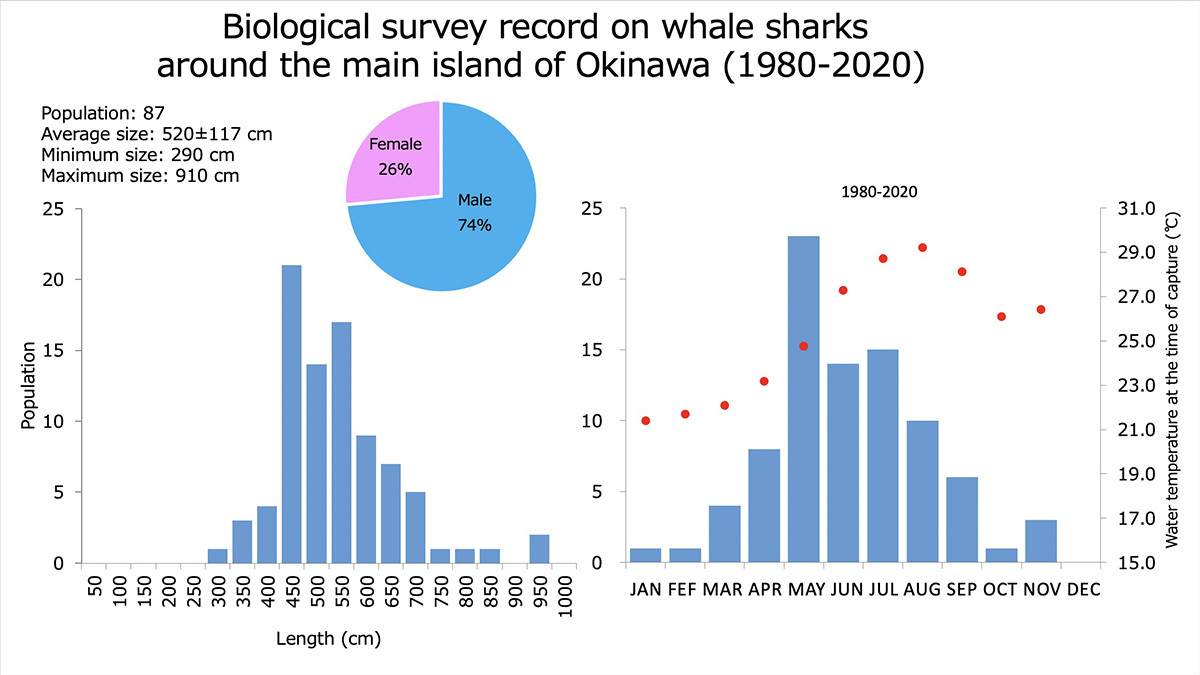
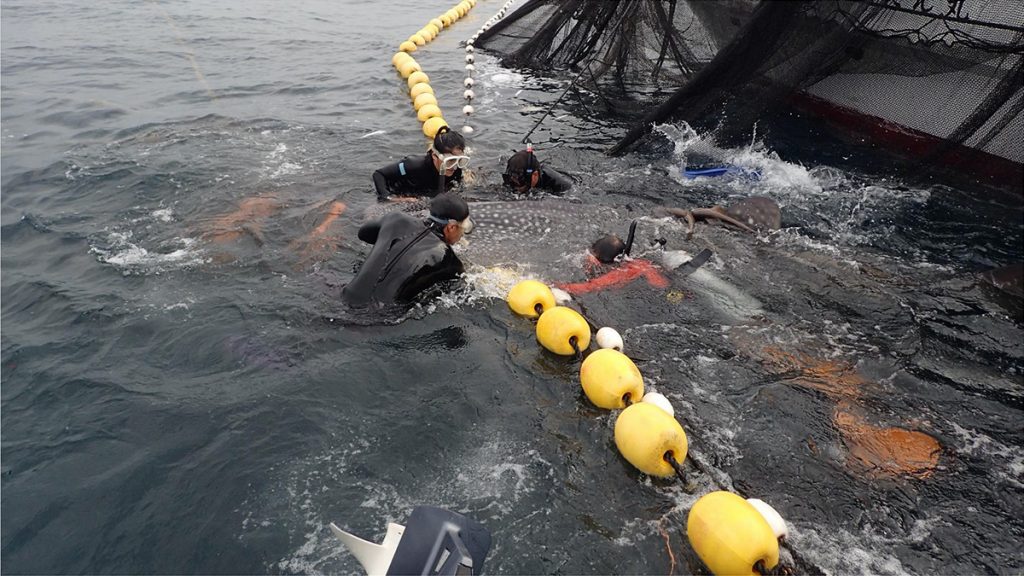
They are sensitive to water temperature changes.
And also, we attached satellite tags to whale sharks caught in fishermen’s nets, and released them to archive the records of migration including location, water depth, water temperature and illumination. These data allow us to know their migrating characteristics.
So this is the biologging.
Right. We released a male individual from Okinawa in the middle of October 2016. It was October, so it’s going to get colder. For that reason, the individual avoided the currents and moved south to the warm waters around the Philippines. We also explored its vertical movement during the period, and could find out that the individual was going deep into the see when the water temperature is high.
Actually, it was known that whale sharks dive deep but we couldn’t figure out why. We could understand a part of the reasons.
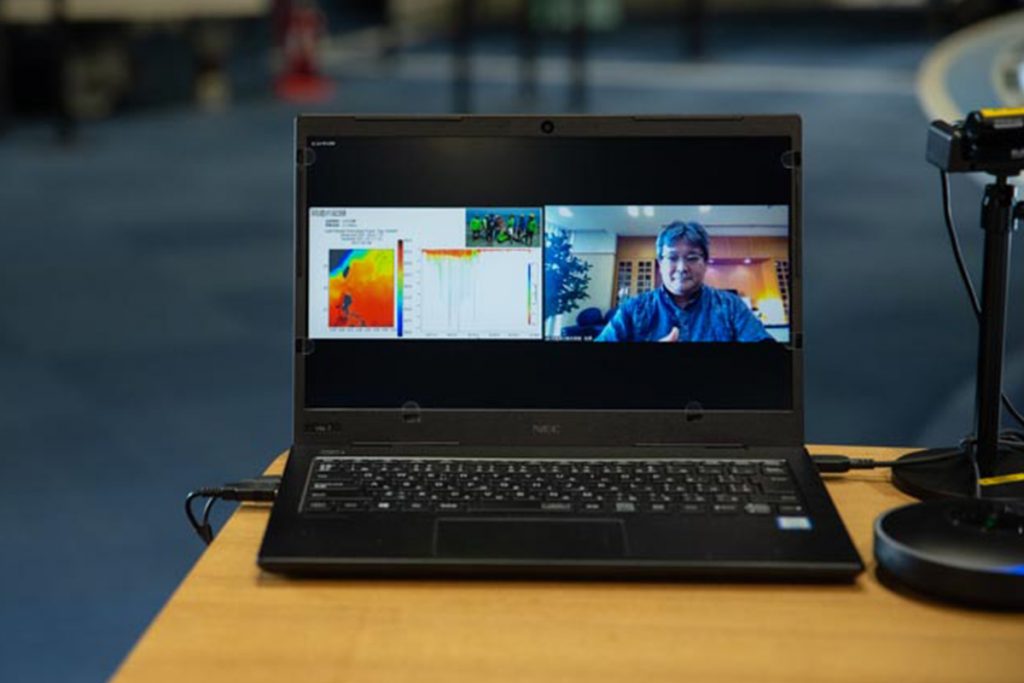
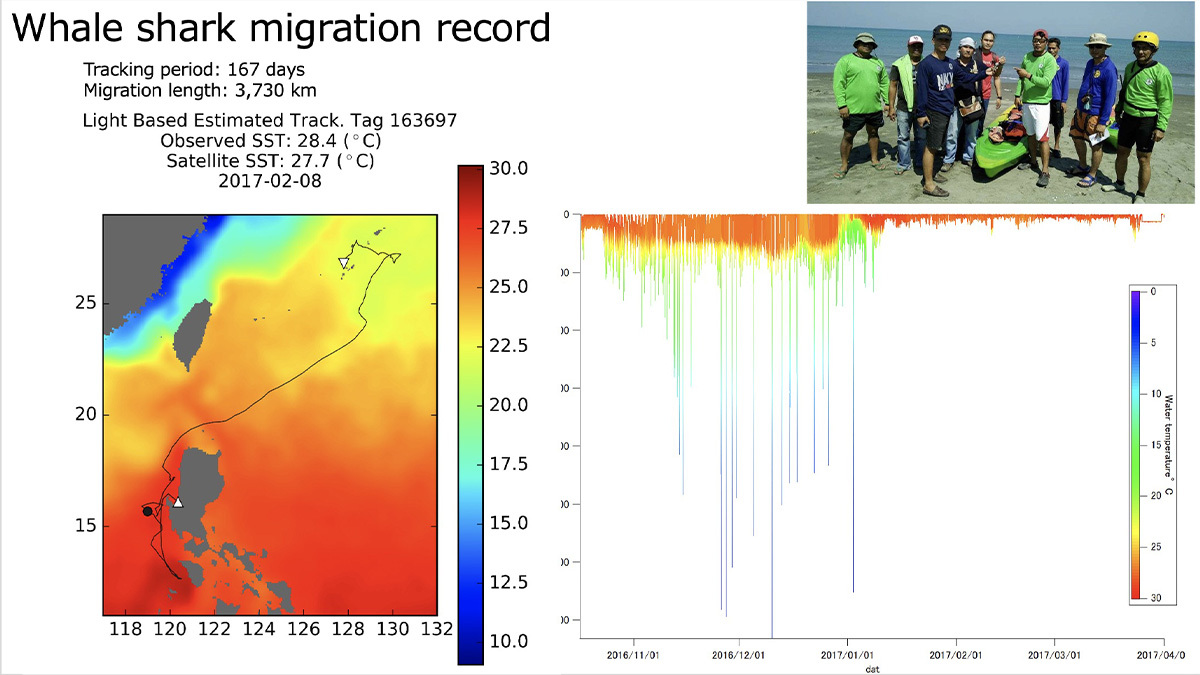
I see. That is a combination of depth data of the whale shark and the sea surface temperature. It’s interesting research.
I would like to show you this picture, too.
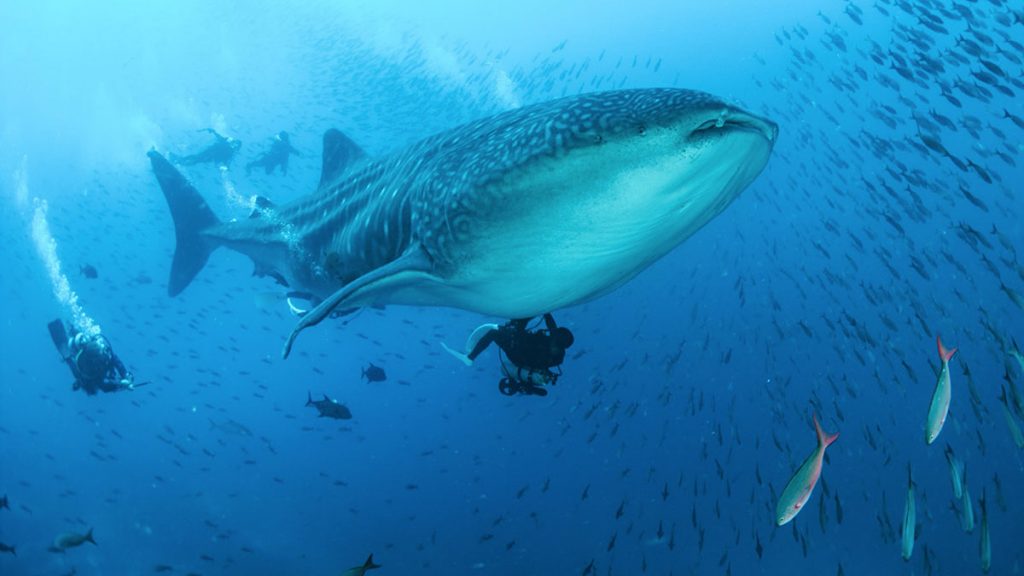
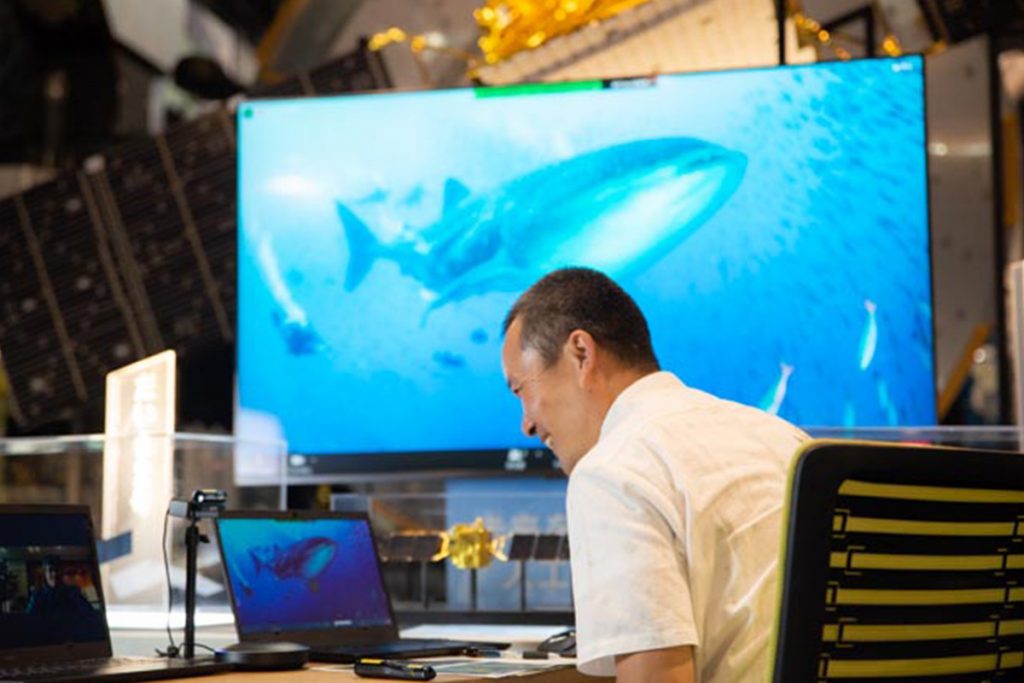
In the picture, I am in the Galapagos doing a survey on whale sharks.
Although we have kind of figure out that whale sharks give birth to about 300 babies, we have no idea where they get pregnant and how long the pregnancy lasts.
That said, because we have bred whale sharks since 1980’s, we have many kinds of technologies to manage their health. For example, blood collecting and ultrasound scan in the water. Our technology allows to see through the body of whale sharks. I thought “If we try to use our technology for wild whale sharks, we will be able to know about them a lot more.” With this in my mind, I was conducting research activities in cooperation with overseas teams in this photo.
Matsumoto-san, what makes a whale shark attractive to you?
Whale sharks are now famous, but we still don’t know much about them. That kind of mystery is attractive. So I’d like to collect ecological data as much as possible and use them for breeding, as well as contribute to conservation activities.
What do you want visitors to see about the whale sharks at the Okinawa Churaumi Aquarium?
Our aquarium’s male whale shark named “Jinta”, has been kept for 26 years, which holds the world record for long-term rearing. Jinta is also the only one in the world that we can see the growth process over such long period of time. Jinta was 4.6 meters in length first, but had grown and reached 8.8 meters for 26 years. We hope that many people come and see Jinta swim majestically, having grown from a child to an adult. Especially, Jinta’s treading water while feeding is incredible.
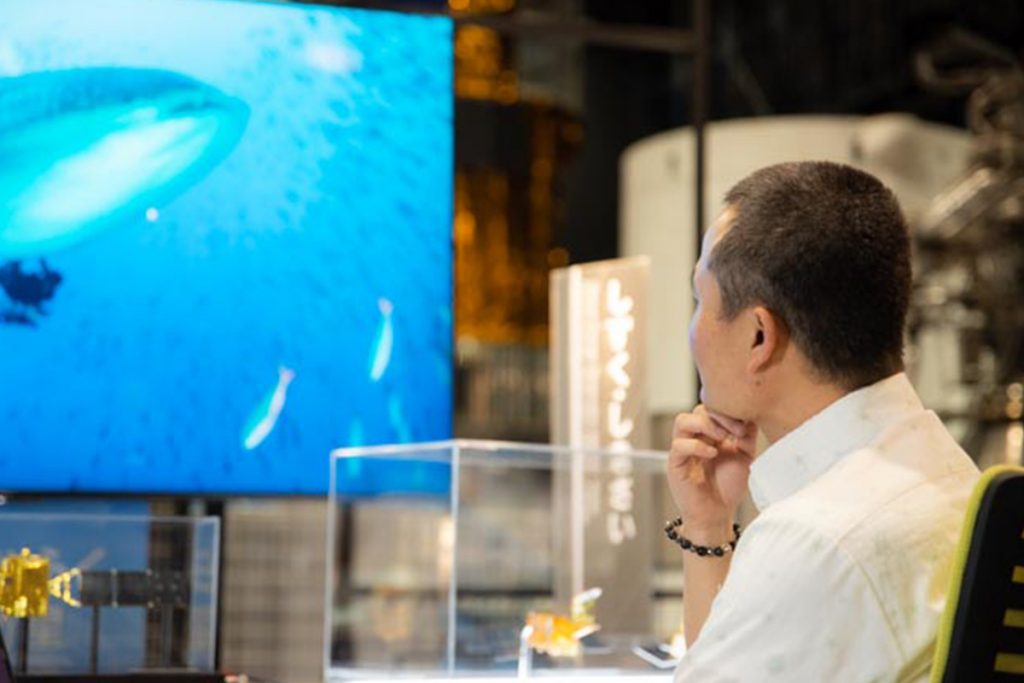
Expectations for new discoveries through data collaboration
By the way, how long do whale sharks live?
It is estimated that they will live to be about 130 years old. If I try to explore all of their lives, I am not able to complete in one generation.
Many of our researches are long term ones. For example, we spent 17 years to figure out the maturation process of whale sharks and 7 years for manta rays.
In order to find out the environment changes and the ecosystems of creatures, we need the extraordinary long-term monitoring. In addition, if we have to analyze its data, it may be difficult to collaborate with universities as a research partner. So I wonder we should rather collaborate with an organization like JAXA.
It would be interesting to tag-team with you, Churaumi Aquarium. Like Earth observation by satellites, it’s necessary for our research to make observations repeatedly for a long term to accumulate data.
At JAXA’s website, data on various natural environments analyzed from satellite images, such as sea surface temperature, chlorophyll-a concentration, ground surface temperature, and precipitation, are available to the public. We hope that they will be useful not only for Churaumi but also for people in various research fields.
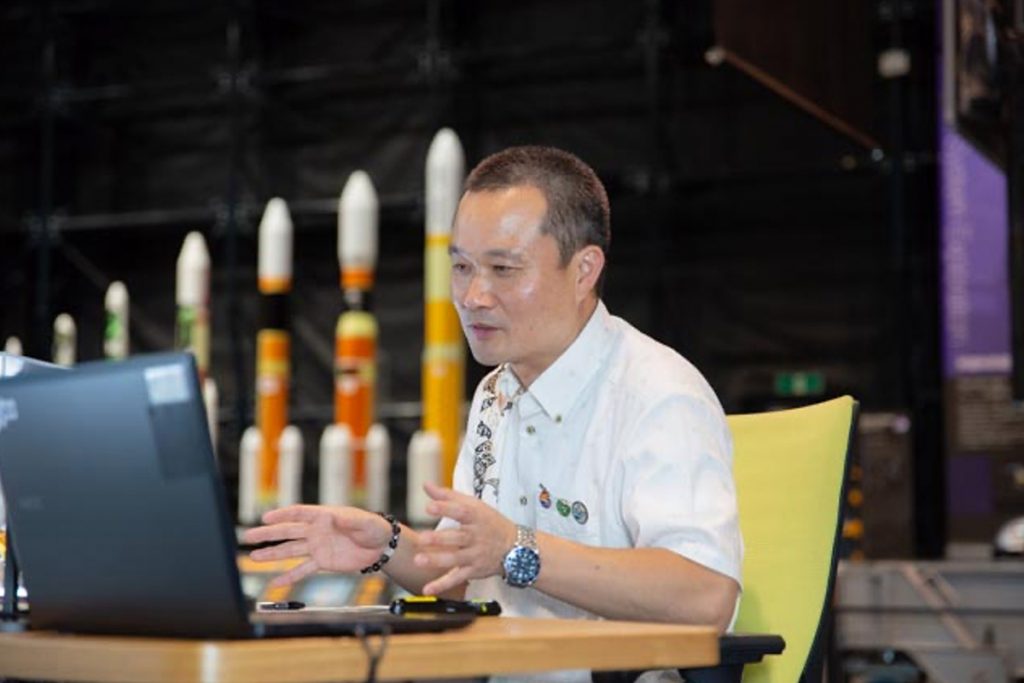
For example, I wonder if it would be interesting to combine the chlorophyll-a concentration data provided by JAXA with behavioral data on migrating creatures such as manta rays, not just whale sharks. Chlorophyll data can be used to see the amount of phytoplankton, which may reveal fundamental ecological information about whether whale sharks and other creatures are migrating in search of food or for other purposes, such as reproduction.
We would be very happy if the combination of your observation data and our satellite images could lead to new discoveries.
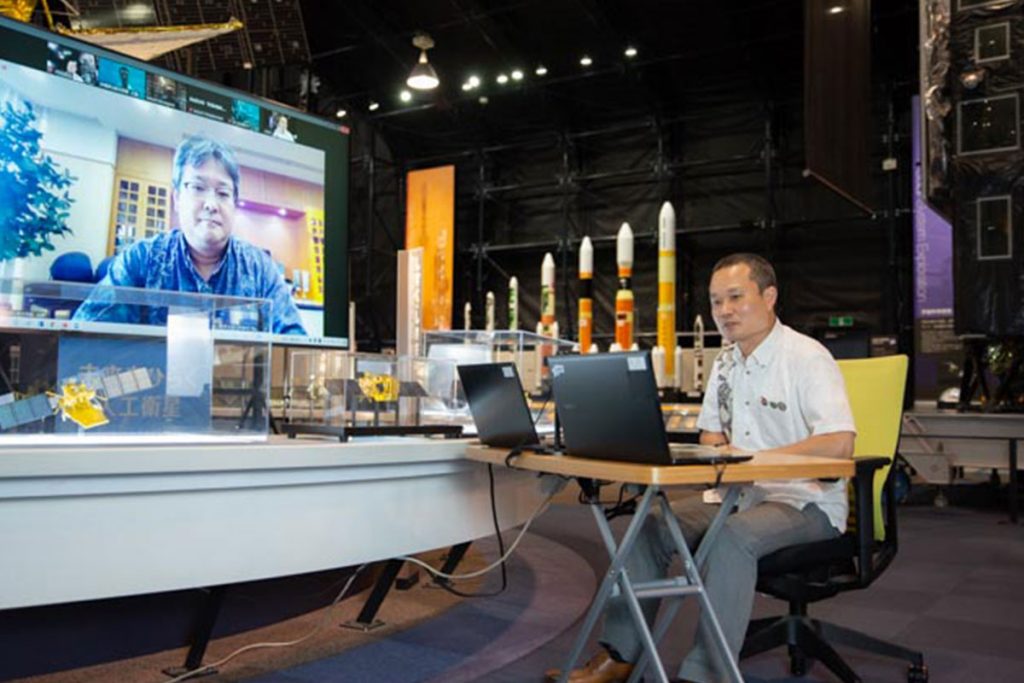
Even data that seems irrelevant at first glance can be related in unexpected ways, so I think it is important to collect and analyze as much data as possible, so-called big data.
There are many ways to monitor nature, but recently we have been looking into a method called “environmental DNA”. For example, one research shows that DNA of organisms was dissolved in seawater scooped out from the ocean in Motobu Ishikawa, and when it was analyzed, DNA of more than 300 species of creatures was detected. Combining such environmental DNA data with satellite data could lead to interesting research. I think it would be even better if it could lead to environmental conservation.
In that sense, we just heard that ALOL-3 will be in operation soon, so I am very much looking forward to getting what kind of data from JAXA in the future.
I can see the potential in that. We will do our best, too.
By the way, the other day, “Amami-Oshima Island, Tokunoshima Island, Northern part of Okinawa Island, and Iriomote Island” were registered as the UNESCO World Natural Heritage List. So how do you feel about this?
Of course we are pleased, but at the same time, we have to recognize that we have a great responsibility to protect this nature. In the small area of Yambaru, how can we protect nature continuously with the increasing number of tourists? I believe that this is a very difficult and serious issue.
At our aquarium, we would like to make an effort to promote awareness among visitors on the importance of environmental conservation. In that case, I think it will be more persuasive if we can combine our survey data with satellite images that provide a bird’s eye view of the entire region and environment. I hope we can take this opportunity to exchange various information with JAXA.
I’m looking forward to working with you.
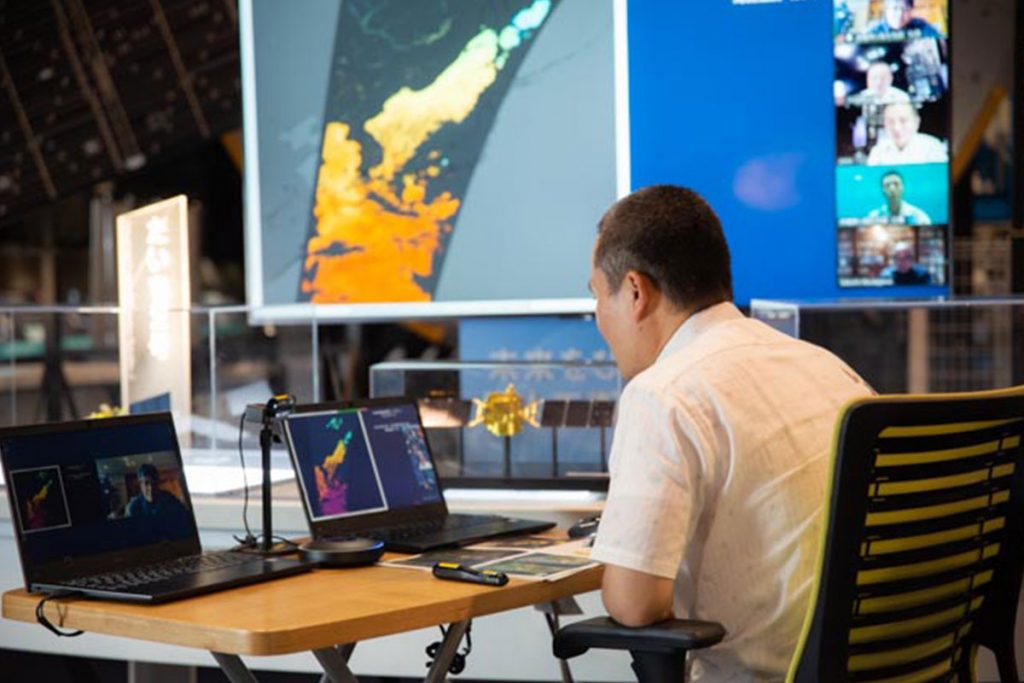
This may be a bit off topic, but I was actually an astronomy enthusiast when I was in junior high and high school. When I was in junior high school, I was very excited to learn that Halley’s Comet was approaching the Earth and that explorers from all over the world would be flying to figure it out. The excitement I felt back then is still with me today.
In this sense, I believe that the ocean and space both have the same dreams and romance, and stimulate the intellectual curiosity of many people who want to know more about them, without considering profit and loss.
Absolutely! The ocean and space are frontier worlds with many mysteries. Rather than dealing with them as different fields, let’s say Churaumi specializes in the ocean and JAXA specializes in space, I think that by fusing them and doing something together, we can make many new discoveries. Somehow I’m excited.
As a space enthusiast, I am so happy to be able to work with people like JAXA who are engaged in space. Whatever it is, let’s do something together, please.
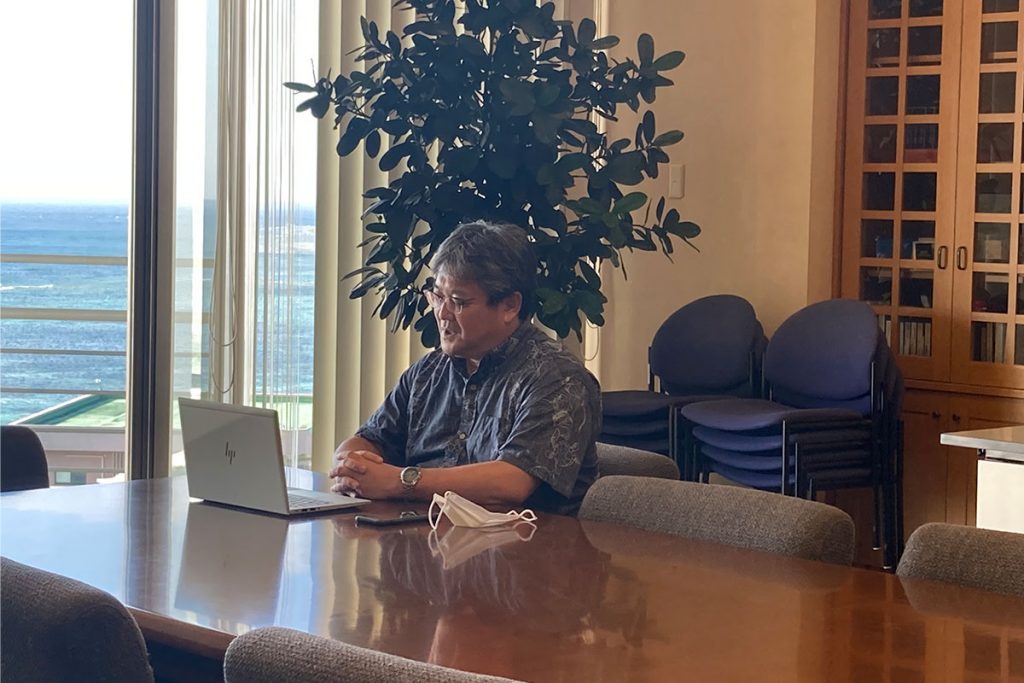
Today’s talk with Churaumi Aquarium is very interesting. New ideas using satellite images will be born. As soon as the COVID-19 crisis subsides, I would like to go to Okinawa for surveys. And I would love to meet you at the Okinawa Churaumi Aquarium and ask to continue today’s talk.
Please come here! We are waiting for you.
I’m looking forward to seeing you again!
Thank you very much for your time today.
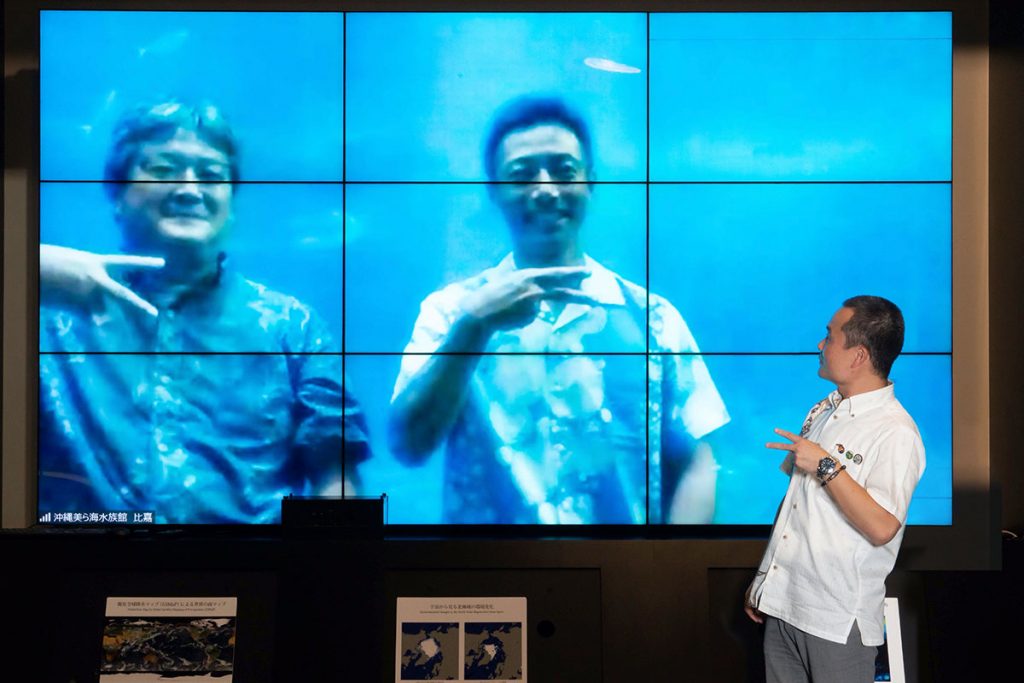
Later (December), Mr. Mizukami was able to visit Okinawa and meet Dr. Sato Keiichi and Dr. Matsumoto Rui at the Okinawa Churaumi Aquarium. Thank you very much, Dr. Sato , Dr. Matsumoto and all the staff at the Okinawa Churaumi Aquarium.
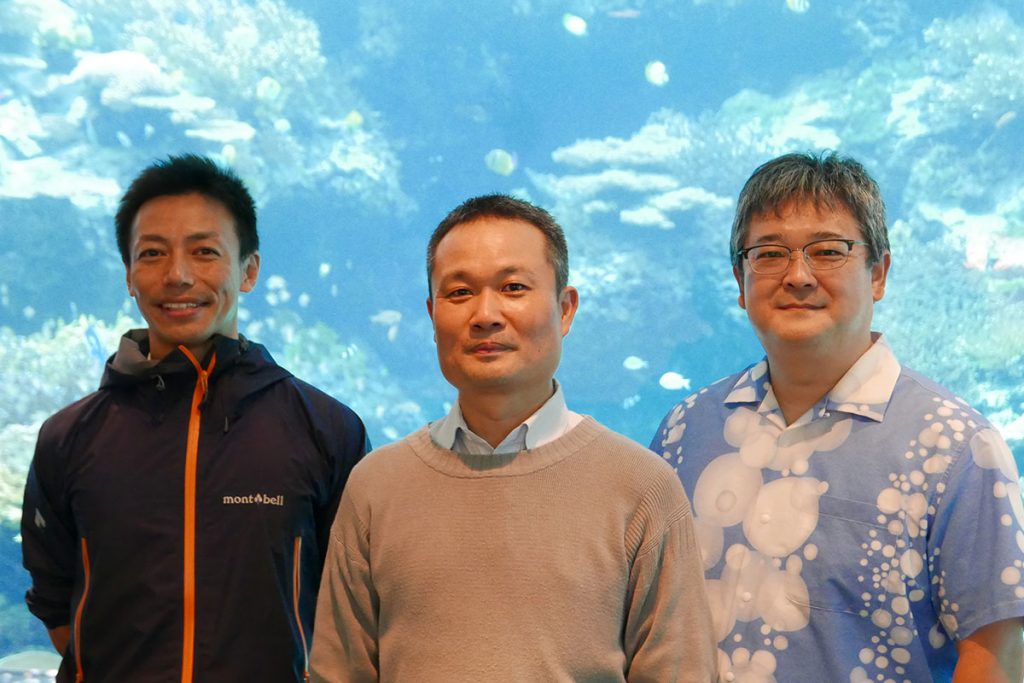
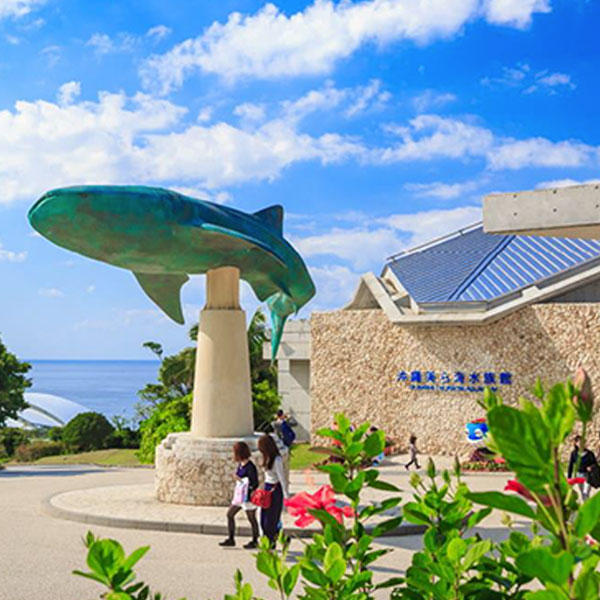
Okinawa Churaumi Aquarium.
Located on Motobu Peninsula in the northwestern part of Okinawa Island, this large aquarium is part of Ocean Expo Park, which was built on the site of the Okinawa International Ocean Expo held in 1975. The main feature is that it introduces a wide variety of marine creatures living in Okinawa. The whale shark and the manta ray, the largest of its kind, are particularly popular. It is also a world-leading research facility for marine life.
905-0206 424 Ishikawa, Motobu-cho, Kunigami-gun, Okinawa Prefecture
TEL.0980-48-3748
https://churaumi.okinawa





